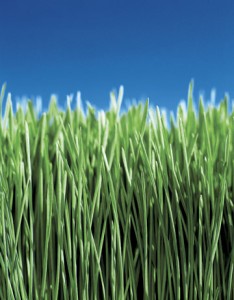
A couple years ago we ditched the Round Up and chemical filled fertilizer for more eco-friendly alternatives. It has taken some time to figure out how to maintain our lawn without chemicals but this summer we’ve found some great methods that are doing the job. I know it would be more eco-friendly not to have a lawn at all but we have two young children who love to run barefoot through it. It doesn’t take any more effort than conventional methods to have a safer, eco-friendly lawn.
- Know how much water your lawn needs. Your lawn only needs 1 inch of water a week and preferably, all at one time. This way the water gets down to the deep roots. To determine how much water your lawn needs, put an empty tuna can in the middle of the yard. Turn on the sprinklers and record how long it takes to fill the tuna can up. Once you know how long it takes, set your sprinkler system to water 1x per week for that length of time. Remember, different parts of your lawn may need different amounts of water. We water 30 minutes, 1x per week in our front yard and 1 hour, 1x per week in our back yard.
- Don’t waste water. Water in the morning. If you water during the day, it evaporates before it hits the ground. We start our watering process at 5am. If you have a sprinkler system, turn it on and watch how each sprinkler head is functioning. Is it overwatering by spraying sidewalks or driveways? Do you have too many sprinkler watering the same area? The spray area on each sprinkler head can be modified, usually with a screwdriver applied to the top. We have turned off about 25% of our sprinkler heads totally because they were watering areas that weren’t planted yet or were overlapping with other sprinkler heads too much.
- Don’t mow too short. Keeping your lawn about 3 inches long
- Use free fertilizer. By leaving your grass clippings on your lawn, you reduce your fertilizer needs by 25%. To keep our garden beds grass clipping free, we bag the grass clippings while mowing and then empty the bag back onto our lawn. You also reduce your trips to the recycling center to take grass clippings.
- Get chicken manure. According to SafeLawns.org, chicken manure is the best fertilizer so we picked it up. This is the product that has made the biggest difference for our lawn. It took a thin, yellow lawn and made it lush, thick and green in about a week. As long as we remember to use it every month, the lawn is awesome. We buy chicken fertilizer at Lowe’s – it’s not any more expensive than conventional fertilizer and it contains no chemicals. SafeLawns recommends one called Chickity Doo Doo. EDITED TO ADD: We don’t use plain chicken manure, it’s an organic fertilizer where the primary component is chicken manure!
Using these methods, we’ve saved money on our water bills and have a safe lawn that I feel totally comfortable having my children play on. For more tips, I highly recommend checking out SafeLawns.org.
Check in tomorrow for tips to keep your garden beds organic AND weed-free!
This is part of the Healthy Child Blog Carnival – an effort by Healthy Child Healthy World to help inspire a movement to protect children from harmful chemicals. For great posts from other green mamas, check some of them out!
- The Most Expensive Egg We’ll Ever Eat by RookieMom
- Clean Food, Dirty Kids by Spoonfed
- Our Grass is Greener by Farmer’s Daughter
- Quick Spray to Save Summer Veggies by Easy Peasy
- How to Relax and Let the Kids Have (Non-Toxic) Fun by Almost All the Truth


